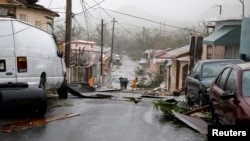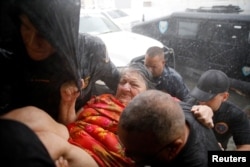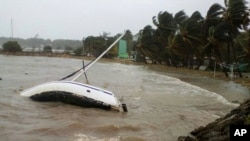The strongest hurricane to hit Puerto Rico in almost 90 years has knocked out power across the entire island of 3.4 million people.
Hurricane Maria, with maximum sustained winds of about 185 kilometers per hour (115 mph), destroyed hundreds of homes and caused heavy flooding after making landfall Wednesday as a Category 4 storm.
By 1800 UTC, Maria had lost considerable strength and was downgraded to a Category 2 storm. Its core was 45 kilometers (28 miles) north-northwest of Aguadilla, Puerto Rico, and moving to the northwest at 19 kilometers per hour (12 mph).
But forecasters said the storm could again become a major hurricane by Thursday.
The storm has left at least nine people dead across the Caribbean. After it blew ashore Wednesday morning along the southeastern coast of Puerto Rico, widespread flooding ensued with reports of many streets being turned into rivers.
There was no immediate word of any deaths or serious injuries in Puerto Rico.
Governor Ricardo Rossello imposed a curfew from 6 p.m. to 6 a.m. daily until Saturday to allow rescue crews and officials to respond to the hurricane's aftermath.
The threats also continued in the U.S. and British Virgin Islands as the back side of the storm moved slowly after its outer eyewall (a ring of thunderstorms) hit St. Croix. The island was spared the devastating eye of the hurricane
In Photos: Hurricane Maria Makes Landfall in Puerto Rico
Forecasters expect the center of the hurricane to move offshore the northern coast of Puerto Rico and reach open water late Wednesday, bringing hurricane conditions to the Dominican Republic late Wednesday and Thursday.
Despite its downgrade, Maria will remain a “dangerous major hurricane” as it approaches the Turks and Caicos Islands and the southeastern Bahamas Thursday and Friday.
As the storm churned slowly across Puerto Rico, it tore roofs off homes, knocked down cell phone towers, snapped trees and unleashed heavy flooding as it dumped at least 50 centimeters (18 inches) of rain.
Trump calls for state of emergency declarations
U.S. President Donald Trump has issued state-of-emergency declarations for Puerto Rico and the U.S. Virgin Islands, where St. Croix sustained heavy damage.
Before arriving at the U.S. territories, Hurricane Maria went directly over the island of Dominica, while also nearly making landfall in Guadeloupe, where at least two people were killed.
Dominica Prime Minister Roosevelt Skerrit wrote on Facebook that initial reports indicate “widespread devastation.” He added the focus is on finding injured or trapped people in rubble, hopefully with the help of international aid.
“We will need help, my friend, we will need help of all kinds,” he said.
Maria is the second major hurricane to pound the Caribbean this month. Hurricane Irma, one of the most powerful Atlantic storms on record, killed 38 people in the Caribbean and another 36 in the United States, leaving a trail of widespread destruction on several Caribbean islands and the Florida Keys.
Maria, tied for eighth as the strongest hurricane in Atlantic history, is the most powerful storm to hit Puerto Rico in nearly 90 years.
The hurricane will likely have an adverse impact on the economy of Puerto Rico, which is struggling with the largest municipal debt crisis in U.S. history.












